Bosch Power Tools 11536C, 11536C-1, 11536C-2 User Manual

BM 1619929800 01-08 1/8/08 9:39 AM Page 1
IMPORTANT: |
IMPORTANT : |
IMPORTANTE: |
Read Before Using |
Lire avant usage |
Leer antes de usar |
Operating/Safety Instructions 
 Consignes de fonctionnement/sécurité
Consignes de fonctionnement/sécurité
Instrucciones de funcionamiento y seguridad
11536C
Call Toll Free for |
Pour obtenir des informations |
Llame gratis para |
Consumer Information |
et les adresses de nos centres |
obtener información |
& Service Locations |
de service après-vente, |
para el consumidor y |
|
appelez ce numéro gratuit |
ubicaciones de servicio |
1-877-BOSCH99 (1-877-267-2499) www.boschtools.com
For English Version |
Version française |
Versión en español |
See page 2 |
Voir page 16 |
Ver la página 30 |
|
|
|
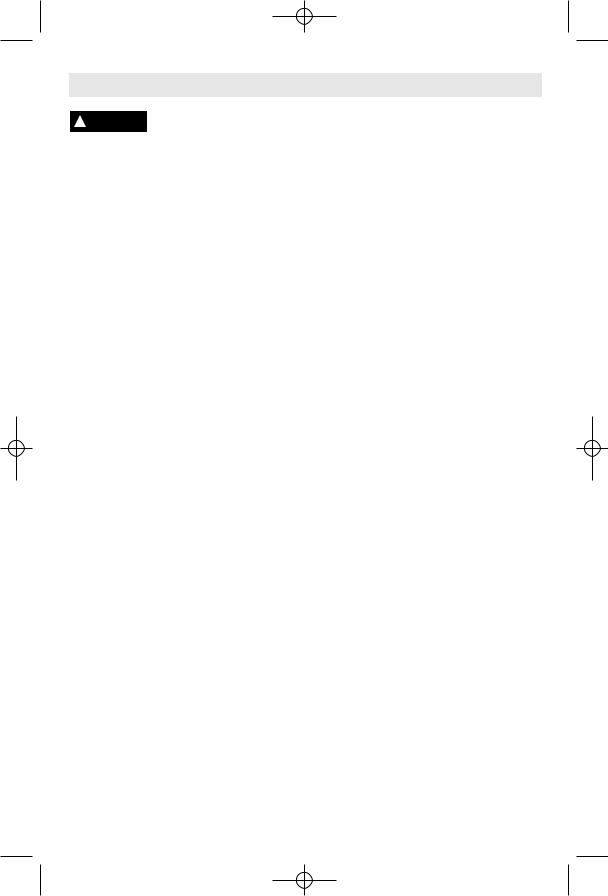
BM 1619929800 01-08 1/8/08 9:39 AM Page 2
General Safety Rules
! WARNING Read all instructions. Failure to follow all instructions listed below may result in electric shock, fire and/or serious injury. The term “power tool” in all
of the warnings listed below refers to your mains-operated (corded) power tool or battery-operated (cordless) power tool.
SAVE THESE INSTRUCTIONS
Work area safety
Keep work area clean and well lit. Cluttered or dark areas invite accidents.
Do not operate power tools in explosive atmospheres, such as in the presence of flammable liquids, gases or dust. Power tools create sparks which may ignite the dust or fumes.
Keep children and bystanders away while operating a power tool. Distractions can cause you to lose control.
Electrical safety
Power tool plugs must match the outlet. Never modify the plug in any way. Do not use any adapter plugs with earthed (grounded) power tools. Unmodified plugs and matching outlets will reduce risk of electric shock.
Avoid body contact with earthed or grounded surfaces such as pipes, radiators, ranges and refrigerators. There is an increased risk of electric shock if your body is earthed or grounded.
Do not expose power tools to rain or wet conditions. Water entering a power tool will increase the risk of electric shock.
Do not abuse the cord. Never use the cord for carrying, pulling or unplugging the power tool. Keep cord away from heat, oil, sharp edges or moving parts. Damaged or entangled cords increase the risk of electric shock.
When operating a power tool outdoors, use an extension cord suitable for outdoor use.
Use of a cord suitable for outdoor use reduces the risk of electric shock.
Do not use AC only rated tools with a DC power supply. While the tool may appear to work, the electrical components of the AC rated tool are likely to fail and create a hazard to the operator.
If operating the power tool in damp locations is unavoidable a Ground Fault
Circuit Interrupter (GFCI) must be used to supply the power to your tool. GFCI and personal protection devices like electrician’s rubber gloves and footwear will further enhance your personal safety.
Personal safety
Stay alert, watch what you are doing and use common sense when operating a power tool. Do not use a power tool while you are tired or under the influence of drugs, alcohol or medication. A moment of inattention while operating power tools may result in serious personal injury.
Use safety equipment. Always wear eye protection. Safety equipment such as dust mask, non-skid safety shoes, hard hat, or hearing protection used for appropriate conditions will reduce personal injuries.
Avoid accidental starting. Ensure the switch is in the off-position before plugging in. Carrying power tools with your finger on the switch or plugging in power tools that have the switch on invites accidents.
Remove any adjusting key or wrench before turning the power tool on. A wrench or a key left attached to a rotating part of the power tool may result in personal injury.
Do not overreach. Keep proper footing and balance at all times. This enables better control of the power tool in unexpected situations.
Dress properly. Do not wear loose clothing or jewelry. Keep your hair, clothing and gloves away from moving parts. Loose clothes, jewelry or long hair can be caught in moving parts.
If devices are provided for the connection of dust extraction and collection facilities, ensure these are connected and properly used. Use of these devices can reduce dustrelated hazards.
Keep handles dry, clean and free from oil and grease. Slippery hands cannot safely control the power tool.
-2-
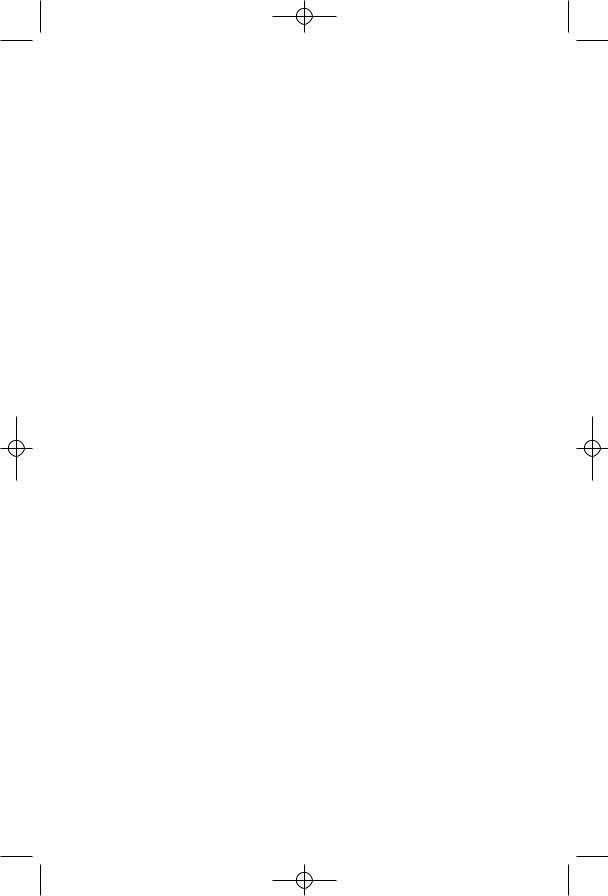
BM 1619929800 01-08 1/8/08 9:39 AM Page 3
Power tool use and care
Do not force the power tool. Use the correct power tool for your application. The correct power tool will do the job better and safer at the rate for which it was designed.
Do not use the power tool if the switch does not turn it on and off. Any power tool that cannot be controlled with the switch is dangerous and must be repaired.
Disconnect the plug from the power source and/or the battery pack from the power tool before making any adjustments, changing accessories, or storing power tools. Such preventive safety measures reduce the risk of starting the power tool accidentally.
Store idle power tools out of the reach of children and do not allow persons unfamiliar with the power tool or these instructions to operate the power tool.
Power tools are dangerous in the hands of untrained users.
Maintain power tools. Check for misalignment or binding of moving parts, breakage of parts and any other condition that may affect the power tools operation. If damaged, have the power tool repaired before use. Many accidents are caused by poorly maintained power tools.
Keep cutting tools sharp and clean.
Properly maintained cutting tools with sharp cutting edges are less likely to bind and are easier to control.
Use the power tool, accessories and tool bits etc., in accordance with these instructions and in the manner intended for the particular type of power tool, taking into account the working conditions and the work to be performed. Use of the power tool for operations different from those intended could result in a hazardous situation.
Use clamps or other practical way to secure and support the workpiece to a stable platform. Holding the work by hand or
against your body is unstable and may lead to loss of control.
Battery tool use and care
Ensure the switch is in the off position before inserting battery pack. Inserting the battery pack into power tools that have the switch on invites accidents.
Recharge only with the charger specified by the manufacturer. A charger that is suitable for one type of battery pack may create a risk of fire when used with another battery pack.
Use power tools only with specifically designated battery packs. Use of any other battery packs may create a risk of injury and fire.
When battery pack is not in use, keep it away from other metal objects like paper clips, coins, keys, nails, screws, or other small metal objects that can make a connection from one terminal to another.
Shorting the battery terminals together may cause burns or a fire.
Under abusive conditions, liquid may be ejected from the battery, avoid contact. If contact accidentally occurs, flush with water. If liquid contacts eyes, additionally seek medical help. Liquid ejected from the battery may cause irritation or burns.
Service
Have your power tool serviced by a qualified repair person using only identical replacement parts. This will ensure that the safety of the power tool is maintained.
Develop a periodic maintenance schedule for your tool. When cleaning a tool be careful not to disassemble any portion of the tool since internal wires may be misplaced or pinched or safety guard return springs may be improperly mounted.
Certain cleaning agents such as gasoline, carbon tetrachloride, ammonia, etc. may damage plastic parts.
SAVE THESE INSTRUCTIONS
-3-

BM 1619929800 01-08 1/8/08 9:39 AM Page 4
Safety Rules for Cordless Hammer Drills
Hold power tools by insulated gripping surfaces when performing an operation where the cutting tools may contact hidden wiring. Contact with a “live” wire will make exposed metal parts of the tool “live” and shock the operator.
Use clamps or other practical way to secure and support the workpiece to a stable platform. Holding the work by hand or against your body is unstable and may lead to loss of control.
Do not drill, fasten or break into existing walls or other blind areas where electrical wiring may exist. If this situation is unavoidable, disconnect all fuses or circuit breakers feeding this worksite.
Wear ear protectors when using the tool for extended periods. Prolonged exposure to high intensity noise can cause hearing loss.
Always use auxiliary handle for maximum control over torque reaction or kick-back.
High torque 3/8" and larger chuck capacity drills are equipped with auxiliary handles.
Always wear safety goggles or eye protection when using this tool. Use a dust mask or respirator for applications which generate dust.
Use thick cushioned gloves and limit the exposure time by taking frequent rest periods. Vibration caused by hammer-drill action may be harmful to your hands and arms.
Secure the material being drilled. Never hold it in your hand or across legs.
Unstable support can cause the drill bit to bind causing loss of control and injury.
Disconnect battery pack from tool before making any assembly, adjustments or changing accessories. Such preventive safety measures reduce the risk of starting the tool accidentally.
Position yourself to avoid being caught between the tool or side handle and walls or posts. Should the bit become bound or jammed in the work, the reaction torque of the tool could crush your hand or leg.
If the bit becomes bound in the workpiece, release the trigger immediately, reverse the
direction of rotation and slowly squeeze the trigger to back out the bit. Be ready for a strong reaction torque. The drill body will tend to twist in the opposite direction as the drill bit is rotating.
Do not grasp the tool or place your hands too close to the spinning chuck or drill bit.
Your hand may be lacerated.
When installing a drill bit, insert the shank of the bit well within the jaws of the chuck.
If the bit is not inserted deep enough, the grip of the jaws over the bit is reduced and the loss of control is increased.
Do not use dull or damaged bits and accessories. Dull or damaged bits have a greater tendency to bind in the workpiece.
When removing the bit from the tool avoid contact with skin and use proper protective gloves when grasping the bit or accessory.
Accessories may be hot after prolonged use.
Check to see that keys and adjusting wrenches are removed from the drill before switching the tool "ON". Keys or wrenches can fly away at high velocity striking you or a bystander.
Do not run the tool while carrying it at your side. A spinning drill bit could become entangled with clothing and injury may result.
! WARNING |
Some dust created by power |
sanding, sawing, grinding, |
drilling, and other construction activities contains chemicals known to cause cancer, birth defects or other reproductive harm. Some examples of these chemicals are:
•Lead from lead-based paints,
•Crystalline silica from bricks and cement and other masonry products, and
•Arsenic and chromium from chemicallytreated lumber.
Your risk from these exposures varies, depending on how often you do this type of work. To reduce your exposure to these chemicals: work in a well ventilated area, and work with approved safety equipment, such as those dust masks that are specially designed to filter out microscopic particles.
-4-
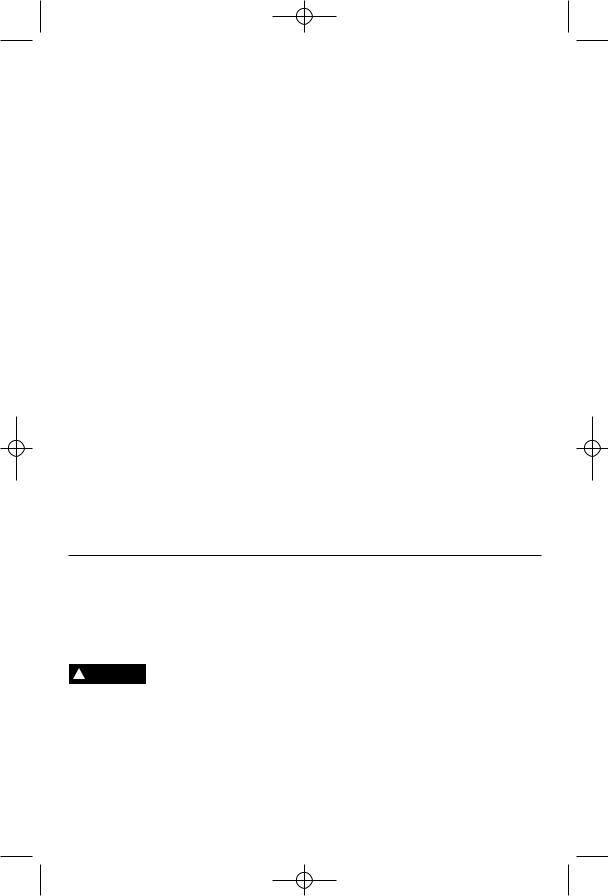
BM 1619929800 01-08 1/8/08 9:39 AM Page 5
Battery/Charger
Before using battery charger, read all instructions and cautionary markings on
(1) battery charger, (2) battery pack, and (3) product using battery.
Use only the charger which accompanied your product or direct replacement as listed in the catalog or this manual. Do not substitute any other charger. Use only Bosch approved chargers with your product. See Functional Description and Specifications.
Do not disassemble charger or operate the charger if it has received a sharp blow, been dropped or otherwise damaged in any way. Replace damaged cord or plugs immediately. Incorrect reassembly or damage may result in electric shock or fire.
Do not recharge battery in damp or wet environment. Do not expose charger to rain or snow. If battery case is cracked or otherwise damaged, do not insert into charger. Battery short or fire may result.
Charge only Bosch approved rechargeable batteries. See Functional Description and Specifications. Other types of batteries may burst causing personal injury and damage.
Charge battery pack in temperatures above +32 degrees F (0 degrees C) and below
+113 degrees F (45 degrees C). Store tool and battery pack in locations where temperatures will not exceed 120 degrees F (49 degrees C). This is important to prevent serious damage to the battery cells.
Battery leakage may occur under extreme usage or temperature conditions. Avoid contact with skin and eyes. The battery liquid is caustic and could cause chemical burns to tissues. If liquid comes in contact with skin, wash quickly with soap and water. If the liquid contacts your eyes, flush them with water for a minimum of 10 minutes and seek medical attention.
Place charger on flat non-flammable surfaces and away from flammable materials when re-charging battery pack.
The charger and battery pack heat during charging. Carpeting and other heat insulating surfaces block proper air circulation which may cause overheating of the charger and battery pack. If smoke or melting of the case are observed unplug the charger immediately and do not use the battery pack or charger.
Use of an attachment not recommended or sold by Bosch will result in a risk of fire, electric shock or injury to persons.
Battery Care
! |
WARNING |
When batteries are not in |
|
tool or charger, keep them |
|||
|
|
away from metal objects. For example, to protect terminals from shorting DO NOT place batteries in a tool box or pocket with
nails, screws, keys, etc. Fire or injury may result.
DO NOT PUT BATTERIES INTO FIRE OR EXPOSE TO HIGH HEAT. They may explode.
-5-
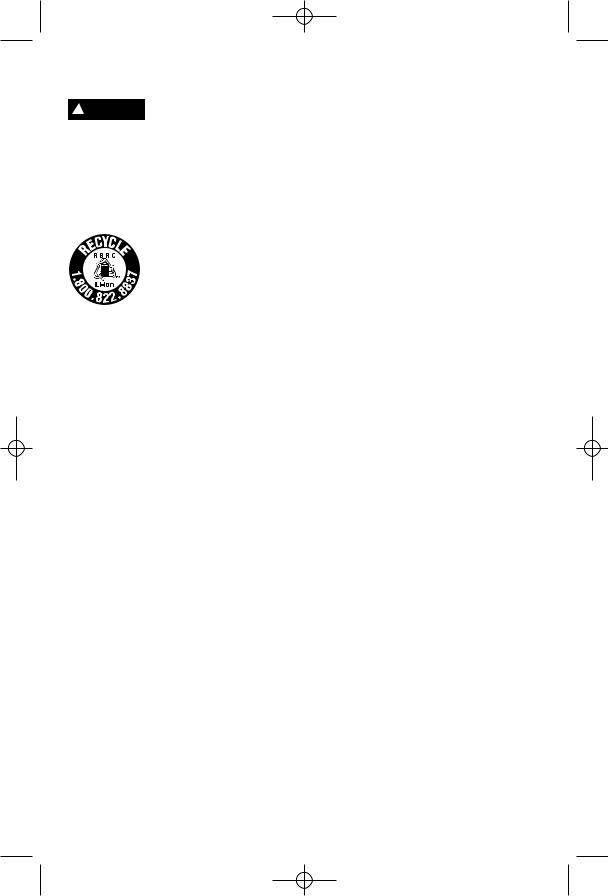
BM 1619929800 01-08 1/8/08 9:39 AM Page 6
Battery Disposal
! WARNING Do not attempt to disassemble the battery or
remove any component projecting from the battery terminals. Fire or injury may result. Prior to disposal, protect exposed terminals with heavy insulating tape to prevent shorting.
LITHIUM-ION BATTERIES
If equipped with a lithium-ion battery, the battery must be collected, recycled or disposed of in an environmentally sound manner.
“The EPA certified RBRC Battery Recycling Seal on the lithium-ion (Li-ion) battery indicates Robert Bosch Tool Corporation is voluntarily participating in an industry
program to collect and recycle these batteries at the end of their useful life, when taken out of service in the United States or Canada. The RBRC program provides a convenient alterative to placing used Li-ion batteries into the trash or the municipal waste stream, which may be illegal in your area.
Please call 1-800-8-BATTERY for information on Li-ion battery recycling and disposal bans/restrictions in your area, or return your batteries to a Skil/Bosch/Dremel Service Center for recycling. Robert Bosch Tool Corporation’s involvement in this program is part of our commitment to preserving our environment and conserving our natural resources.”
-6-
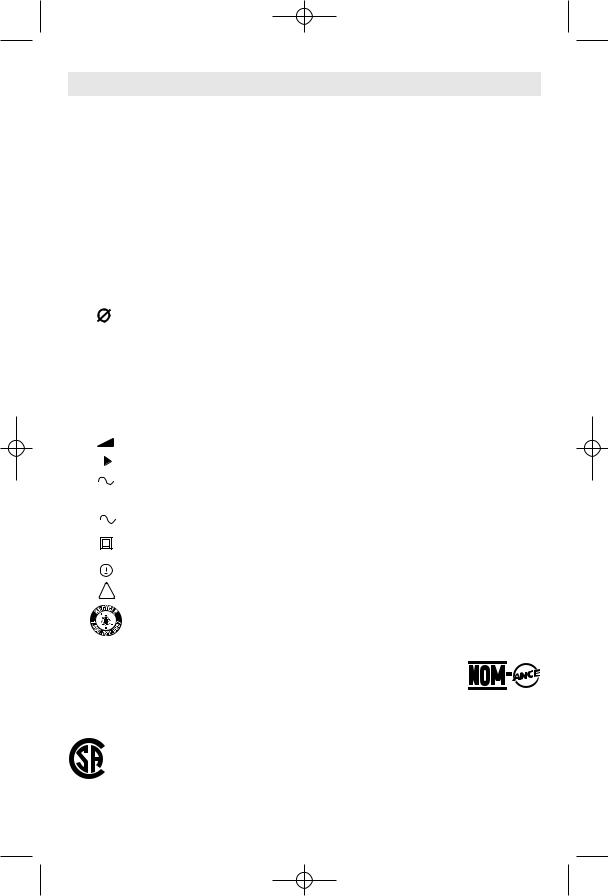
BM 1619929800 01-08 1/8/08 9:39 AM Page 7
Symbols
IMPORTANT: Some of the following symbols may be used on your tool. Please study them and learn their meaning. Proper interpretation of these symbols will allow you to operate the tool better and safer.
Symbol |
Name |
Designation/Explanation |
||||||
V |
Volts |
Voltage (potential) |
||||||
A |
Amperes |
Current |
||||||
Hz |
Hertz |
Frequency (cycles per second) |
||||||
W |
Watt |
Power |
||||||
kg |
Kilograms |
Weight |
||||||
min |
Minutes |
Time |
||||||
|
s |
Seconds |
Time |
|||||
|
|
|
|
|
|
|
Diameter |
Size of drill bits, grinding wheels, etc. |
n0 |
No load speed |
Rotational speed, at no load |
||||||
.../min |
Revolutions or reciprocation per minute |
Revolutions, strokes, surface speed, |
||||||
|
|
|
|
|
|
|
|
orbits etc. per minute |
0 |
|
|
|
Off position |
Zero speed, zero torque... |
|||
1, 2, 3, ... |
Selector settings |
Speed, torque or position settings. |
||||||
I, II, III, |
|
Higher number means greater speed |
||||||
0 |
|
|
|
|
|
Infinitely variable selector with off |
Speed is increasing from 0 setting |
|
|
|
|
|
|
|
|
Arrow |
Action in the direction of arrow |
|
|
|
|
|
|
|
||
|
|
|
|
|
|
|
Alternating current |
Type or a characteristic of current |
|
|
|
|
|
|
|
Direct current |
Type or a characteristic of current |
|
|
|
|
|
|
|
||
|
|
|
|
|
|
|
||
|
|
|
|
|
|
|
Alternating or direct current |
Type or a characteristic of current |
|
|
|
|
|
|
|
||
|
|
|
|
|
|
|
Class II construction |
Designates Double Insulated |
|
|
|
|
|
|
|
||
|
|
|
|
|
|
|
|
Construction tools. |
|
|
|
|
|
|
|
|
|
|
|
|
|
|
|
|
Earthing terminal |
Grounding terminal |
|
|
|
|
|
|
|
||
|
|
|
|
|
|
|
Warning symbol |
Alerts user to warning messages |
|
|
|
|
|
|
|
||
|
|
|
|
|
|
|
||
|
|
|
|
|
|
|
Li-ion RBRC seal |
Designates Li-ion battery recycling |
|
|
|
|
|
|
|
|
program |
|
|
|
|
|
|
|
|
|
This symbol designates that this tool is listed by Underwriters Laboratories.
This symbol designates that this tool is listed by the Canadian Standards Association.
This symbol designates that this tool is listed to Canadian Standards by Underwriters Laboratories.
This symbol designates that this tool is listed by Underwriters Laboratories, and listed to Canadian Standards by Underwriters Laboratories.
This symbol designates that
this tool complies to NOM Mexican Standards.
-7-
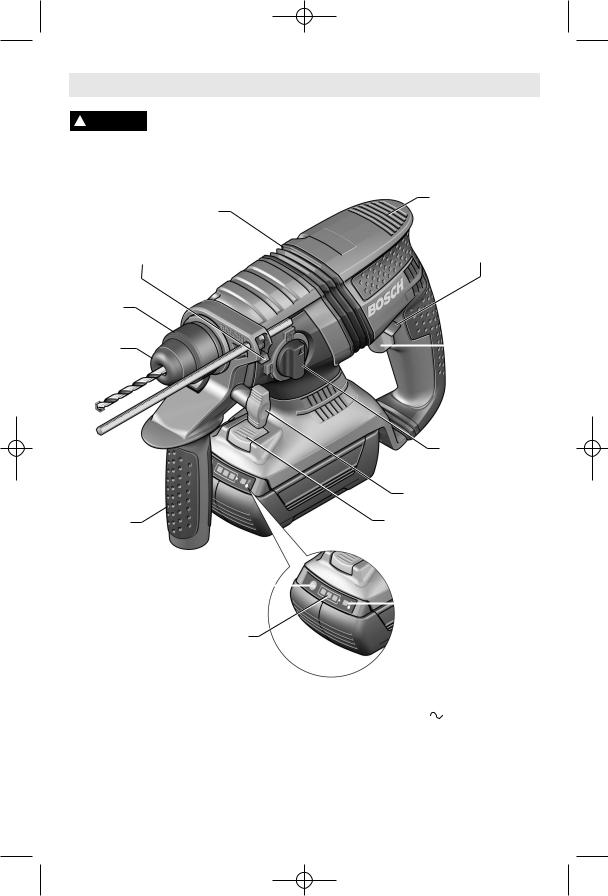
BM 1619929800 01-08 1/8/08 9:39 AM Page 8
Functional Description and Specifications
Disconnect battery pack from tool or place the switch in the locked or off ! WARNING position before making any assembly, adjustments or changing
accessories. Such preventive safety measures reduce the risk of starting the tool accidentally.
Cordless Hammer Drill |
|
|
||||
|
|
|
|
|
|
|
|
FIG. 1 |
VENTILATION OPENINGS |
||||
VIBRATION DAMPER |
||||||
|
|
|||||
HANDLE / HAMMER MECHANISM |
|
|
||||
|
|
|
|
FORWARD/REVERSING |
||
DEPTH GAUGE |
|
LEVER |
||||
RELEASE LEVER |
& TRIGGER LOCK |
|||||
LOCKING |
|
|
||||
SLEEVE |
|
VARIABLE |
||||
|
|
|
|
|
||
DUST |
|
|
SPEED |
|||
|
|
CONTROLLED |
||||
|
|
|||||
SHIELD |
|
TRIGGER |
||||
|
|
|
|
|
SWITCH |
|
|
|
|
|
|
|
|
DRILL/HAMMER DRILL |
|
|
|
|
|
|
|
|
SELECTION DIAL |
|
DEPTH |
||||||||
|
|
|
|
|
|
|||
GAUGE |
|
|
|
|
|
|
||
|
|
|
|
|
|
WING KNOB |
||
AUXILIARY |
|
|
|
|
BATTERY PACK |
|||
HANDLE |
|
|
|
|
||||
|
|
|
|
RELEASE BUTTON |
||||
|
|
|
|
|
|
|||
|
|
|
|
|||||
|
|
BATTERY PACK |
||||||
|
|
BUTTON |
|
|
|
TEMPERATURE |
||
|
|
|
||||||
|
|
|
|
|
|
|
||
|
|
|
|
|
|
|
INDICATOR LIGHT |
|
|
|
BATTERY CHARGED |
||||||
|
|
CONDITION INDICATOR |
||||||
Model Number |
11536C |
|
Charger |
BC830 |
|
|||
Voltage rating |
36 V |
|
|
|
|
Voltage rating |
120 V |
60 Hz |
|
|
|||||||
|
|
|
|
|||||
Shank style |
SDS-plus® |
|
Battery pack |
BAT810 thru BAT840 |
||||
Maximum Capacities: |
|
|
|
|
|
Charge time |
1 hour |
|
Material |
|
|
|
|
|
|
(80% charged in 30 minutes) |
|
Concrete |
3/4" |
|
|
|
|
NOTE: For tool specifications refer to the |
||
Steel |
1/2" |
|
|
|
|
|||
Wood |
1-1/4" |
|
|
|
|
nameplate on your tool. |
||
|
|
|
|
|
-8- |
|
|
|
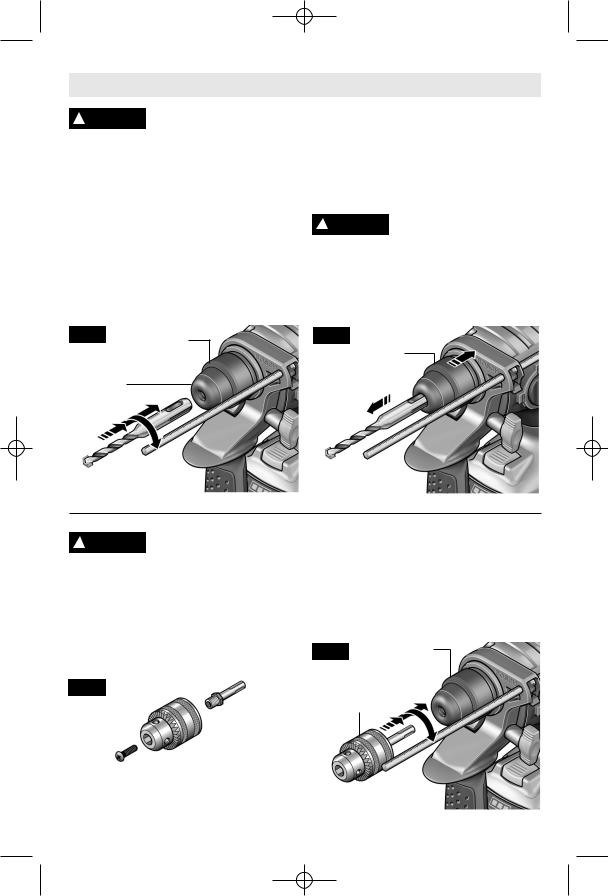
BM 1619929800 01-08 1/8/08 9:39 AM Page 9
Assembly
! WARNING |
Disconnect battery pack |
from tool or place the |
switch in the locked or off position before making any assembly, adjustments or changing accessories. Such preventive safety measures reduce the risk of starting the tool accidentally.
INSTALLING SDS-plus® ACCESSORIES
Clean the insert shank end of the accessory to remove any debris, then lightly grease with a light oil or lubricant
Insert accessory into the chuck through the dust shield, while twisting and pushing inward until it locks automatically into place. Pull outward on the accessory to be certain it is locked into the chuck (Fig. 2).
FIG. 2 |
SDS-plus® |
|
CHUCK |
DUST
SHIELD
NOTE: The high efficiency available from the rotary hammers can only be obtained if sharp and undamaged accessories are used. The "cost" to maintain sharp and undamaged accessories is more than offset by the "time saved" in operating the tool with sharp accessories.
REMOVING SDS-plus® ACCESSORIES
! WARNING Accessories may be hot after use. Avoid contact with skin
and use proper protective gloves or cloth to remove.
To remove an accessory, pull locking sleeve backward and pull bit forward. All accessories should be wiped clean after removing (Fig. 3).
FIG. 3
LOCKING
SLEEVE
! WARNING Disconnect battery pack from tool or place the
switch in the locked or off position before making any assembly, adjustments or changing accessories. Such preventive safety measures reduce the risk of starting the tool accidentally.
INSTALLING & REMOVING 3-JAW CHUCK (Not included, available as accessory)
The 3 Jaw Chuck with SDS Shank can convert your tool for use with straight shank bits (Fig. 4).
FIG. 4
Clean the insert shank end of the accessory to remove any debris, then lightly grease with a light oil or lubricant
Insert accessory into the chuck through the dust shield, while twisting and pushing inward until it locks automatically into place. Pull outward on the accessory to be certain it is locked into the chuck (Fig. 5).
To remove the chuck, pull the locking sleeve backward (towards the rear of tool), while pulling the chuck forward.
FIG. 5 |
LOCKING |
|
SLEEVE |
3-JAW CHUCK (Not included, available
as accessory)
-9-
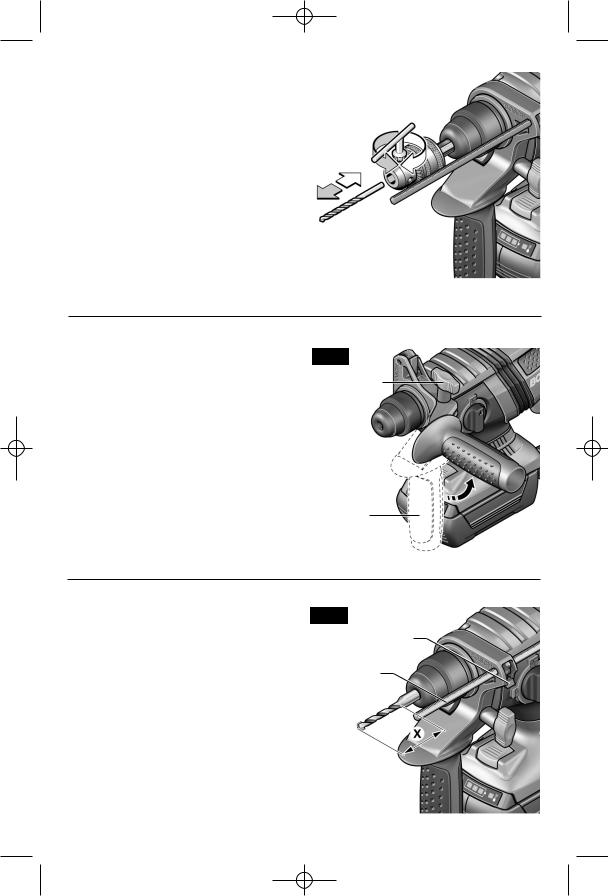
BM 1619929800 01-08 1/8/08 9:39 AM Page 10
INSTALLING & REMOVING ACCESSORIES |
|
|
FIG. 6 |
||
3-JAW CHUCK |
||
|
||
For small bits, open jaws enough to insert the |
|
|
bit up to the flutes. For large bits, insert the bit |
|
|
as far as it will go. Center the bit as you close |
|
|
the jaws by hand. This positions the bit |
|
|
properly, giving maximum contact between the |
|
|
chuck jaws and the bit shank (Fig. 6). |
|
|
To tighten chuck, insert key into each of the |
|
|
three key holes in succession and tighten |
|
|
clockwise firmly. |
|
|
The chuck can be released by using one hole only. |
|
|
Note: The 3-Jaw Chuck is for use only in “Drill |
|
|
only” mode. The 3-Jaw Chuck is not for use |
|
|
when drilling with hammering action. |
|
AUXILIARY HANDLE
The auxiliary handle will provide additional control, support and guidance for the tool. The handle is adjustable around the 360° handle collar mount.
To mount, loosen wing knob and slide handle completely over chuck onto the collar mount and tighten wing knob (Fig. 7).
FIG. 7
WING KNOB
AUXILIARY HANDLE
DEPTH GAUGE
Your drilling depth can be pre-set and/or repeated by using the depth gauge.
Setting depth: After the auxiliary handle is installed, make sure the accessory has been fully inserted into the tool holder before setting the depth gauge (Fig. 8).
To adjust depth, push down on the depth gauge release lever, slide the depth gauge to desired depth and release pressure on lever to lock the depth gauge in place (Fig. 8).
FIG. 8
DEPTH GAUGE
RELEASE LEVER
DEPTH GAUGE
-10-
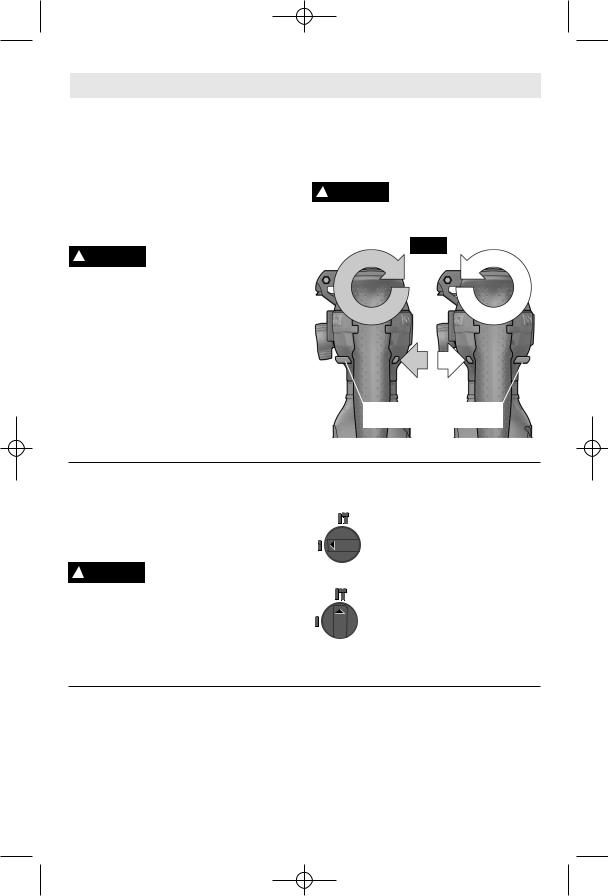
BM 1619929800 01-08 1/8/08 9:39 AM Page 11
Operating Instructions
VARIABLE SPEED CONTROLLED
TRIGGER SWITCH
Your tool is equipped with a variable speed trigger switch. The tool can be turned "ON" or "OFF" by squeezing or releasing the trigger. The speed can be adjusted from the minimum to maximum nameplate RPM by the pressure you apply to the trigger. Apply more pressure to increase the speed and release pressure to decrease speed Fig. 1).
! WARNING To reduce the risk of injury immediately discontinue use
of the tool if the variable speed control ceases to function. Subsequent loss of on/off control of the trigger switch is likely.
FORWARD/REVERSING LEVER &
TRIGGER LOCK
Your tool is equipped with a forward/ reversing lever and trigger lock located above the trigger (Fig. 9). This lever was designed for changing rotation of the chuck, and for locking the trigger in an “OFF” position to help prevent accidental starts and accidental battery discharge.
For forward rotation, (with chuck pointed away from you) move the lever to the far left. For reverse rotation move the lever to the far right. To activate trigger lock move lever to the center off position.
! CAUTION Do not change direction of rotation until the tool comes to
a complete stop. Shifting during rotation of the chuck can cause damage to the tool.
FIG. 9
FORWARD/REVERSING LEVER
& TRIGGER LOCK
DRILL/HAMMER DRILL SELECTION DIAL
The selector dial allows the tool to be set for various drilling/hammer drilling applications. Rotate the selector dial right or left depending on the below applications (Fig. 1).
! CAUTION Do not operate the selection dial until the tool
come to a complete stop. Shifting during rotation of the chuck can cause damage to the tool.
Do not use demolition or chipping bits such as bull points, chisels, spades, gouges, etc.
Drill only action: For drilling in woods, metals, plastics or other non concrete materials.
Drill with hammer action: For drilling in concrete, asphalt, tile or other similar hard materials.
SLIP CLUTCH
The tool has a internal pre-set slip clutch. The output spindle will stop rotating if the accessory binds and overloads the tool.
BRAKE
When the trigger is released it activates the electrical brake to stop the chuck quickly. This
is especially useful in the repetitive driving and removal of screws.
VIBRATION DAMPER HANDLE /
HAMMER MECHANISM
The integrated vibration damper in the main handle and hammer mechanism reduces vibrations (Fig. 1).
-11-
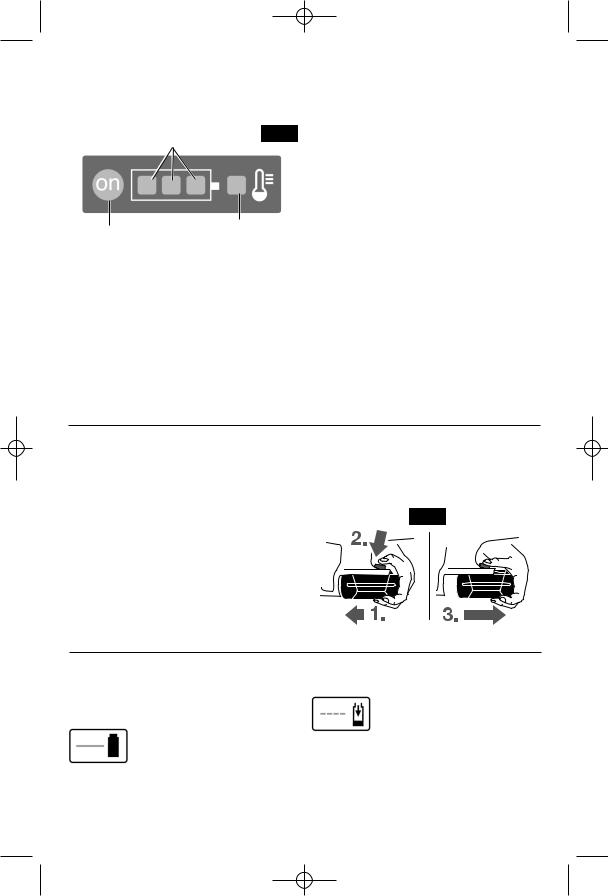
BM 1619929800 01-08 1/8/08 9:39 AM Page 12
BATTERY CHARGED CONDITION
INDICATOR
The battery is equipped with a charged condition indicator (Fig. 10).
GREEN |
FIG. 10 |
INDICATOR LIGHTS |
|
BUTTON |
RED |
|
INDICATOR LIGHT |
||
|
By pressing the button ON, the charged condition can be checked when the battery is removed or when the machine is not in use. After approx. 5 seconds, the charged indicator switches off automatically.
•• • When all three lights are illuminated, this indicates the battery pack is between 67% and 100% charged.
•• When only two lights illuminate, this indicates the battery pack is between 33% and 66% charged.
• When only one light illuminates, this indicates the battery pack is less than 33% charged.
When one light blinks the battery pack is almost fully discharged.
TEMPERATURE INDICATOR LIGHT
The red indicator light signals whether the battery or tool (with battery inserted) is in the optimum temperature range. When the temperature is too high, the tool will not operate at full capacity.
If the red indicator light illuminates continuously when the battery is inserted into the charger. The battery is outside the charging temperature range and cannot be charged.
If the red indicator light blinks when the button or on/off switch (with battery inserted) is pressed, the battery is outside the operating range of -10 ˚C to +60 ˚C.
When the temperature is above 70 ˚C the battery turns off until it’s in the optimum temperature range.
INSERTING AND RELEASING BATTERY PACK
Set Forward/Reversing lever to the center (off position). Slide charged battery pack into the housing until the battery pack locks into position and the red warning label is no longer visible (Fig. 1).
Your battery pack is equipped with a secondary locking latch to prevent the battery pack from completely falling out of the handle, should it become loose due to vibration.
To remove the battery pack, press the battery pack release button and slide the battery pack forward. The red warning label will become
partially visible. Press the battery pack release button again and slide the battery pack completely out of tool housing (Fig. 11).
FIG. 11
CHARGER INDICATORS, SYMBOLS AND MEANING
If the indicator lights are “OFF”, the charger is not receiving power from power supply outlet.
If the green indicator light is “ON”, the charger is plugged in but the battery pack is not
inserted, or the battery pack is fully charged.
If the green indicator light is “BLINKING”, the battery pack is being fast-charged. Fast-
charging will automatically stop when the battery pack is fully charged.
-12-
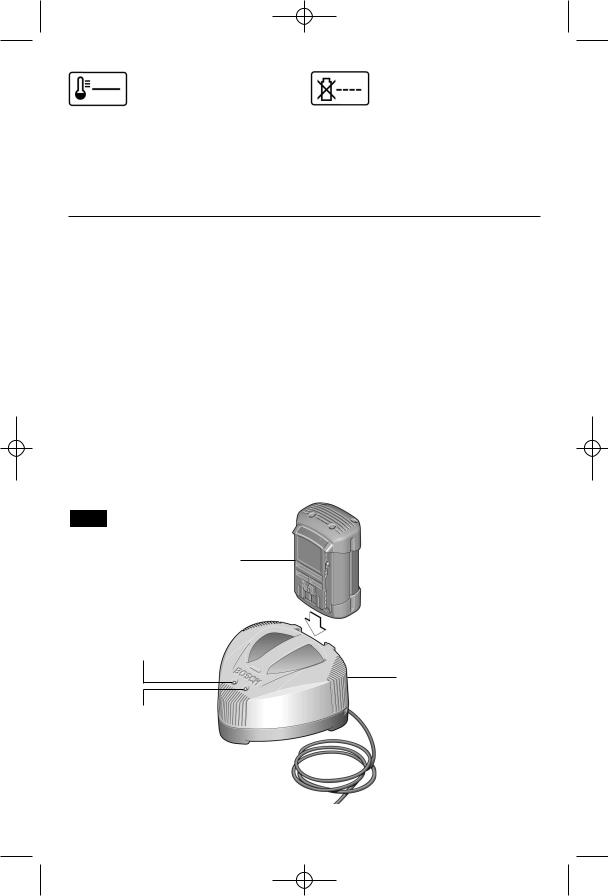
BM 1619929800 01-08 1/8/08 9:39 AM Page 13
If the red indicator light is “ON”, the battery pack is too hot or cold for fast-charging. The charger
will automatically switch to fast-charging once a suitable temperature is reached.
If the red indicator light is “BLINKING”, the battery pack cannot accept a charge or the
contacts of the charger or battery pack are contaminated. Clean the contacts of the charger or battery pack only as directed in these operating instructions or those supplied with your tool or battery pack.
CHARGING BATTERY PACK (BC830 1 HOUR CHARGER)
Plug charger cord into your standard power outlet, then insert battery pack into charger (Fig. 12).
The charger’s green indicator light will begin to “BLINK”. This indicates that the battery is receiving a fast charge. Fast-charging will automatically stop when the battery pack is fully charged.
When the unit beeps and the indicator light stops “BLINKING” (and becomes a steady green light) fast charging is complete.
The battery pack may be used even though the light may still be blinking. The light may require more time to stop blinking depending on temperature. When you begin the charging process of the battery pack, a steady red light
could also mean the battery pack is too hot or too cold.
The purpose of the green light is to indicate that the battery pack is fast-charging. It does not indicate the exact point of full charge. The light will stop blinking in less time if the battery pack was not completely discharged.
When needed, the internal fan of the charger will turn on to aid the charging process and speed.
When charging several batteries in sequence, the charge time may slightly increase.
When the battery pack is fully charged, unplug the charger (unless you're charging another battery pack) and slip the battery pack back into the tool.
FIG. 12
BATTERY PACK
RED LIGHT
CHARGER
GREEN LIGHT
-13-
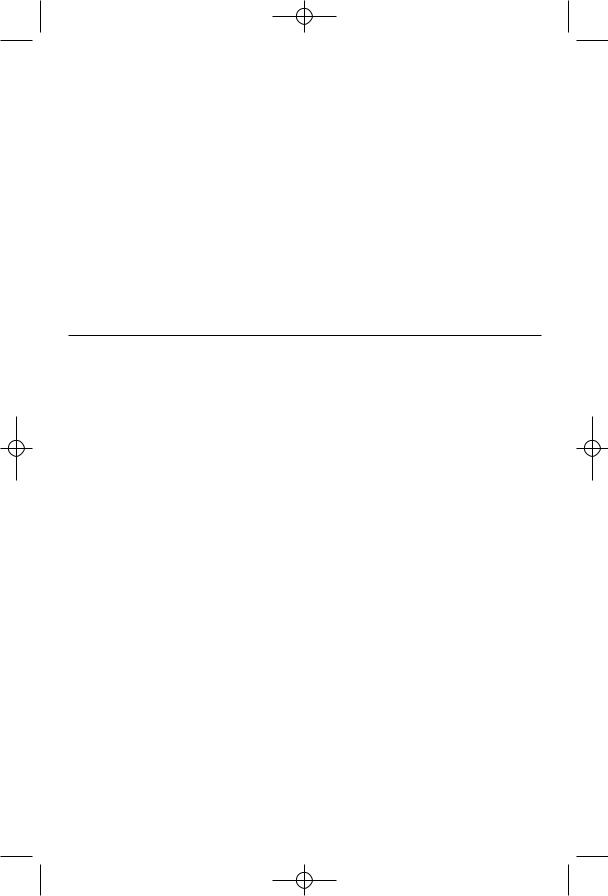
BM 1619929800 01-08 1/8/08 9:39 AM Page 14
IMPORTANT CHARGING NOTES
1.The charger was designed to fast charge the battery only when the battery temperature is between 32˚F (0˚C) and 113˚F (45˚C). If the battery pack is too hot or too cold, the charger will not fast charge the battery. (This may happen if the battery pack is hot from heavy use). When the battery temperature returns to between 32˚F (0˚C) and 113˚F (45˚C), the charger will automatically begin charging.
2.A substantial drop in operating time per charge may mean that the battery pack is nearing the end of its life and should be replaced.
3.Remember to unplug charger during storage period.
4.If battery does not charge properly:
a.Check for voltage at outlet by plugging in some other electrical device.
b.Check to see if outlet is connected to a light switch which turns power “off” when lights are turned off.
c.Check battery pack terminals for dirt. Clean with cotton swab and alcohol if necessary.
d.If you still do not get proper charging, take or send tool, battery pack and charger to your local Bosch Service Center. See “Tools, Electric” in the Yellow Pages for names and addresses.
Note: Use of chargers or battery packs not sold by Bosch will void the warranty.
TOOL TIPS
Following a few simple tips will reduce wear on the tool and the chance of injury to the operator.
NOTE: The high efficiency available from the rotary hammers can only be obtained if sharp and undamaged accessories are used. The “cost” to maintain sharp and undamaged accessories is more than offset by the “time saved” in operating the tool with sharp accessories.
You will extend the life of your bits and do neater work if you always put the bit in contact with the workpiece BEFORE pulling the trigger. During operation, hold the drill firmly and exert moderate, steady pressure. Too much pressure at low speed will stall the hammer. Too little pressure will keep the bit from cutting and cause excess friction by sliding over the surface. This can be damaging to the drill and bit.
Shanks of all drill bits should be wiped clean prior to using and immediately after removing.
Recall these instructions for safe operation:
1.Some materials require slow drilling speeds; whereas, others require higher speed to produce the best results.
2.All work must be supported or secured before drilling and steady, even pressure applied in line with the drill bit.
3.As the drill bit cuts through the opposite side, reduce the pressure and continue running the drill as the bit is withdrawn.
Materials such as glass, porcelain, ceramics, tiles, plastics, etc., should be drilled at low speeds with specially designed drill bits and lubricants.
DRILLING WOOD OR PLASTIC
If backing block is not used, ease up on the pressure just before the bit breaks through the wood to avoid splintering. Complete the hole from the opposite side immediately after the point breaks through. If bit binds, reverse the drilling operation to help remove the bit from the work.
DRILLING METAL
Make a center punch in the material for easier starting. Use enough pressure to keep the bit cutting. If the bit is allowed to merely spin in the hole, it will become dull within a short time. When drilling a larger hole, it is faster and easier on your power pack to first make a smaller hole and enlarge it to the required size. Lubricate the tip of the bit occasionally with CUTTING OIL for easier metal drilling. If bit binds, reverse the drilling to help remove the bit from the work.
DRILLING MASONRY
Use carbide-tipped masonry bit for cinder block, mortar, common brick, soft stone and other materials. The amount of pressure to be used is dependent upon the type of material being drilled. Soft materials require less pressure while the hard materials need more pressure to prevent the drill bit from spinning.
-14-
